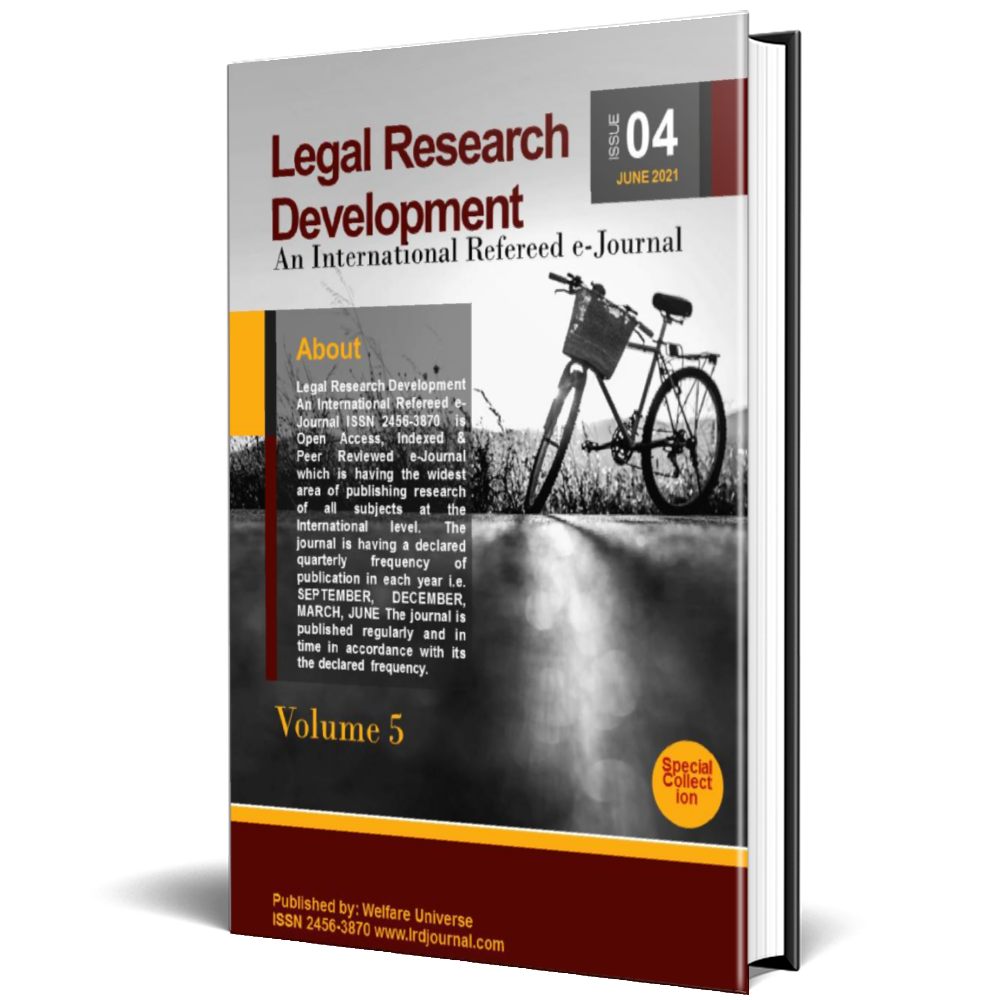The Hidden Dangers of Mobile Radiation: Exploring its Impact on Human Health
DOI:
https://doi.org/10.53724/lrd/v9n1.4Keywords:
Cell phone technology, electromagnetic radiation (EMR),, mobile towers, thermal effects, non-thermal effects, DNA damage, neurological disorders, cancer risk, reproductive dysfunctions, public health, children, pregnant women, Indian Council of Medical Research (ICMR), regulatory oversight, Telegraph Act, Municipalities Act, low-SAR devices, mobile usage, public awareness, health risks, environmental concerns, constitutional rights, Article 21, mobile radiation prevention, policy enforcementAbstract
The swift development of cell phone technology in recent years has improved connectivity and convenience, but it also raises serious environmental and health issues. In India, where there are over 440,000 mobile phone towers and 400–500 million cell phone users, the issue of unregulated installations that generate electromagnetic radiation (EMR) is becoming more and more problematic. These radiations, which fall into two distinct groups: thermal and non-thermal effects, have been linked to a number of detrimental health effects, such as increased risk for cancer, neurological problems, and DNA damage. Children, expectant mothers, and those who live close to towers belong to the vulnerable groups that are more at risk from exposure.
In India, research investigations by academic institutions and the Indian Council of Medical Research (ICMR) have linked long-term exposure to EMR to neurological impairments, cellular damage, and reproductive dysfunctions. Despite the data, public awareness is still low and regulatory monitoring is insufficient. Legislative frameworks like as the Telegraph Act and the Municipalities Act mandate tower installation permits; nonetheless, there are still operational gaps.
It is crucial to take preventative measures including utilizing low-SAR devices, reducing mobile usage, and making sure towers are situated far from crowded places. To protect public health and preserve Article 21 constitutional rights to life and dignity, governments must improve public education, impose more stringent laws, and guarantee compliance. The long-term health concerns linked with mobile radiation can be reduced by collaboration among telecom providers, the judiciary, and lawmakers.
References
Guru Nanak Dev University, "DNA Damage and Mobile Radiation," 2007.
International Agency for Research on Cancer (IARC), WHO Classification of Radiofrequency Radiation, 2011.
Environmental Impact Studies on EMR and Biodiversity, Global Reports, 2015.
Postgraduate Institute of Medical Education and Research (GIMER), Chandigarh, Recommendations on Mobile Radiation, 2010.
IARC, "Mobile Phones and Cancer Risk," WHO, 2011.
Gandhi, G., and Singh, A., "Impact of Mobile Radiation on Children," 2010.
Department of Telecommunications (DoT), "Guidelines on EMR from Mobile Towers," 2013.
International Agency for Research on Cancer (IARC), WHO Classification of Radiofrequency Radiation, 2011.
Gandhi, G., & Anita, B., "Effects of Mobile Radiation on Biological Systems," Guru Nanak Dev University, 2007.
Behari, J., "Microwave Radiation Effects on Biological Systems," Jawaharlal Nehru University, 2008.
International Agency for Research on Cancer (IARC), WHO Classification of Radiofrequency Radiation, 2011.
Indian Council of Medical Research (ICMR), Study on Neurological Impacts of EMF Exposure, 2010.
Gandhi, G., & Anita, B., "Effects of Mobile Radiation on Reproductive Systems," Guru Nanak Dev University, 2007.
Behari, J., "Microwave Radiation Effects on Reproductive Health," Jawaharlal Nehru University, 2008.
International Agency for Research on Cancer (IARC), WHO Classification of Radiofrequency Radiation, 2011.
Hardell, L., Carlberg, M., & Hansson Mild, K., "Mobile Phone Use and Brain Tumor Risk," International Journal of Oncology, 2009.
Gandhi, G., & Anita, B., "Vulnerability of Children to Mobile Radiation," Guru Nanak Dev University, 2007.
BioInitiative Report (2012), "Fetal Development and EMR Exposure," BioInitiative Working Group.
Balmori, A., "Mobile Phone Radiation Effects on Wildlife," Electromagnetic Biology and Medicine, 2009.
Sharma, V. P., & Kumar, N. R., "Mobile Phone Radiation and Its Impact on Bees," Current Science, 2010.
Behari, J., "Microwave Radiation Effects on Reproductive Health," Jawaharlal Nehru University, 2008.
Gandhi, G., & Anita, B., "Effects of Mobile Radiation on Human Lymphocytes," Guru Nanak Dev University,2007.
Hardell, L., Carlberg, M., & Hansson Mild, K., "Mobile Phone Use and Cellular Damage," International Journal of Oncology, 2009.
Panda, S. P., "GIMER Study on Mobile Radiation," Postgraduate Institute of Medical Education and Research, Chandigarh, 2010.
Indian Council of Medical Research, "Study on Neurological and Reproductive Effects of EMR," ICMR, Delhi, 2010.
Sharma, N., "Research by ICMR on Specific Absorption Rate (SAR)," ICMR Journal, 2012.
Indian Telegraph Act, 1885, Section 10(c), Government of India.
Department of Telecommunications, "Guidelines on Installation of Cell Towers," Ministry of Communications, 2010.
Indian Telegraph Act, 1885, Section 10(c), Government of India.
International Commission on Non-Ionizing Radiation Protection (ICNIRP), "SAR Limits for Mobile Devices," 2010.
Government of India, Ministry of Health and Family Welfare, "Public Awareness on Mobile Radiation," 2015.
Johnson, M., "Technological Advancements in Reducing Mobile Radiation Exposure," Journal of Technology and Health, 2017.
Department of Telecommunications, "Regulatory Guidelines for Cell Tower Installation," Ministry of Communications, 2018.
WHO, "Personal Precautions for Reducing Mobile Phone Radiation Exposure," World Health Organization, 2017.
Swedish Radiation Safety Authority, "Regulations for Radiation Protection in Sweden," 2016.
Swiss Federal Office for the Environment, "Mobile Phone Radiation Safety Standards," 2015.
The Royal Society for the Protection of Birds, "Effects of Electromagnetic Fields on Birds," 2018.
The International Union for Conservation of Nature (IUCN), "Impact of Electromagnetic Radiation on Bee Populations," 2017.
Environmental Protection Agency (EPA), "Studies on the Effects of EMF Exposure on Plants," 2019.
National Institute for Environmental Health Sciences (NIEHS), "Research on Long-Term Biological Effects of EMR," 2020.
Department of Telecommunications, Government of India, "Revised Guidelines for Mobile Tower Installations," 2018.
International Telecommunication Union (ITU), "Global Collaboration on Radiation Safety Standards," 2019.
Behari, J., & ICMR. "Microwave Radiations Effects on Reproductive Systems of Male Rats," School of Environmental Sciences, Jawaharlal Nehru University, 2008.
Indian Council of Medical Research (ICMR), Research on Neurological and Reproductive Effects of Cell Phone Usage, June 2010
Gandhi, G., & Anita. (2007). Study on DNA and chromosomal damage due to mobile phone radiation, Guru Nanak Dev University, Amritsar.
Gandhi, G., et al. (2005). Research on behavioral and physiological alterations caused by radiofrequency radiation exposure.
Panda et al. (2010). Study on mobile phone radiation and its health impacts, PGIMER, Chandigarh.
Recommendations from the PGIMER study on mitigating electromagnetic radiation exposure through safe mobile phone usage practices.
Sharma, R. (2017). Constitutional Law of India. LexisNexis.
Patel, P. (2020). Telecommunications Law and Policy in India. SAGE Publications.
Verma, N. (2016). The Indian Telegraph Act: Regulatory Framework. University Press.
Mehta, A., & Dube, R. (2018). Telecom Regulations and Their Impact on Public Health. New Delhi: National Press.
Sharma, R. (2017). Constitutional Law of India. LexisNexis.
Patel, P. (2020). Telecommunications Law and Policy in India. SAGE Publications.
Gandhi, G., & Anita (2007). Health impacts of mobile phone radiation. Guru Nanak Dev University, Amritsar.
WHO. (2011). Radiofrequency electromagnetic fields and health effects. World Health Organization.
ICMR. (2010). Research on Neurological and Reproductive Effects of Cell Phone Usage.
Panda, S., et al. (2010). Mobile phone radiation guidelines. PGIMER, Chandigarh.
Gandhi, G. (2005). Behavioral and physiological impacts of mobile radiation.
Kumar, R. (2014). Mobile Phone Safety Measures. Journal of Health and Communication, 12(3).
Sharma, V. (2012). Comparison of wired and wireless communication for health. Thesis, IIT Kanpur.
Gandhi, G., et al. (2008). Electromagnetic radiation and safety protocols.
WHO and ITU. (2013). Global radiation exposure standards.
Mishra, P. (2010). Radiation Absorption Studies. International Journal of Radiobiology.
Singh, A. (2015). Cell phone usage and health risks. Article in Health Today.
Gupta, M. (2016). Reducing cell phone radiation exposure: Practical tips.
Gandhi, G. (2007). Mobile Phones and Electromagnetic Fields. Research Paper.
WHO. (2005). Signal Strength and Radiation Levels: A Guide.
ICMR. (2012). Best Practices for Mobile Phone Usage.
Panda, S., et al. (2010). Safe Mobile Communication Practices.
Sharma, V. (2012). Wired Communication in the Modern Era.
Gandhi, G., & Anita (2007). Youth Vulnerability to Mobile Radiation.
WHO. (2011). Medical Implants and Mobile Radiation Risks.
Downloads
Published
How to Cite
Issue
Section
License
Copyright (c) 2024 Legal Research Development

This work is licensed under a Creative Commons Attribution-NonCommercial 4.0 International License.










